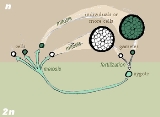
Biological life cycle
Overview
A life cycle is a period involving all different generation
s of a species
succeeding each other through means of reproduction, whether through asexual reproduction
or sexual reproduction
(a period from one generation of organisms to the same identical). For example, a complex life cycle of Fasciola hepatica
includes three different multicellular generations: 1) "adult" hermaphroditic; 2) sporocyst
; 3) redia
.
In regard to changes of ploidy
, there are 3 types of cycles:
These three types of cycles feature alternating haploid and all germinates
.
Generation
Generation , also known as procreation in biological sciences, is the act of producing offspring....
s of a species
Species
In biology, a species is one of the basic units of biological classification and a taxonomic rank. A species is often defined as a group of organisms capable of interbreeding and producing fertile offspring. While in many cases this definition is adequate, more precise or differing measures are...
succeeding each other through means of reproduction, whether through asexual reproduction
Asexual reproduction
Asexual reproduction is a mode of reproduction by which offspring arise from a single parent, and inherit the genes of that parent only, it is reproduction which does not involve meiosis, ploidy reduction, or fertilization. A more stringent definition is agamogenesis which is reproduction without...
or sexual reproduction
Sexual reproduction
Sexual reproduction is the creation of a new organism by combining the genetic material of two organisms. There are two main processes during sexual reproduction; they are: meiosis, involving the halving of the number of chromosomes; and fertilization, involving the fusion of two gametes and the...
(a period from one generation of organisms to the same identical). For example, a complex life cycle of Fasciola hepatica
Fasciola hepatica
Fasciola hepatica, also known as the common liver fluke or sheep liver fluke, is a parasitic flatworm of the class Trematoda, phylum Platyhelminthes that infects the livers of various mammals, including humans. The disease caused by the fluke is called fascioliasis . F...
includes three different multicellular generations: 1) "adult" hermaphroditic; 2) sporocyst
Sporocyst
Sporocyst is a common name of a lifecycle stage in two unrelated groups of species:*Apicomplexa parasites: see Apicomplexa lifecycle stages*Trematode flatworms: see Trematode lifecycle stages...
; 3) redia
Redia
Redia or redia can be:-*A synonym for the plant genus Cleidion of the family Euphorbiaceae*A stage in the development of a trematode*A dipstick for urinalysis, determining levels of glucose, albumin and erythrocytes...
.
In regard to changes of ploidy
Ploidy
Ploidy is the number of sets of chromosomes in a biological cell.Human sex cells have one complete set of chromosomes from the male or female parent. Sex cells, also called gametes, combine to produce somatic cells. Somatic cells, therefore, have twice as many chromosomes. The haploid number is...
, there are 3 types of cycles:
- haplontic life cycle
- diplontic life cycle
- diplobiontic life cycle (also referred to as diplohaplontic, haplodiplontic, or dibiontic life cycle)
These three types of cycles feature alternating haploid and all germinates
Germination
Germination is the process in which a plant or fungus emerges from a seed or spore, respectively, and begins growth. The most common example of germination is the sprouting of a seedling from a seed of an angiosperm or gymnosperm. However the growth of a sporeling from a spore, for example the...
.
Unanswered Questions

